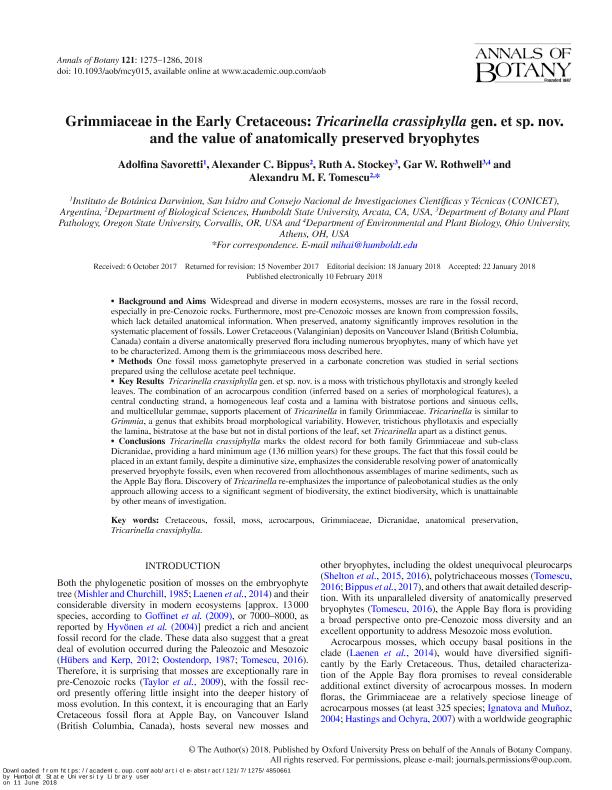Artículo
Grimmiaceae in the Early Cretaceous: Tricarinella crassiphylla gen. et sp. nov. and the value of anatomically preserved bryophytes
Savoretti, María Adolfina ; Bippus, Alexander C.; Stockey, Ruth A.; Rothwell, Gar W.; Tomescu, Alexandru M. F.
; Bippus, Alexander C.; Stockey, Ruth A.; Rothwell, Gar W.; Tomescu, Alexandru M. F.
 ; Bippus, Alexander C.; Stockey, Ruth A.; Rothwell, Gar W.; Tomescu, Alexandru M. F.
; Bippus, Alexander C.; Stockey, Ruth A.; Rothwell, Gar W.; Tomescu, Alexandru M. F.
Fecha de publicación:
06/2018
Editorial:
Oxford University Press
Revista:
Annals of Botany
ISSN:
0305-7364
Idioma:
Inglés
Tipo de recurso:
Artículo publicado
Clasificación temática:
Resumen
Background and Aims Widespread and diverse in modern ecosystems, mosses are rare in the fossil record, especially in pre-Cenozoic rocks. Furthermore, most pre-Cenozoic mosses are known from compression fossils, which lack detailed anatomical information. When preserved, anatomy significantly improves resolution in the systematic placement of fossils. Lower Cretaceous (Valanginian) deposits on Vancouver Island (British Columbia, Canada) contain a diverse anatomically preserved flora including numerous bryophytes, many of which have yet to be characterized. Among them is the grimmiaceous moss described here. Methods One fossil moss gametophyte preserved in a carbonate concretion was studied in serial sections prepared using the cellulose acetate peel technique. Key Results Tricarinella crassiphylla gen. et sp. nov. is a moss with tristichous phyllotaxis and strongly keeled leaves. The combination of an acrocarpous condition (inferred based on a series of morphological features), a central conducting strand, a homogeneous leaf costa and a lamina with bistratose portions and sinuous cells, and multicellular gemmae, supports placement of Tricarinella in family Grimmiaceae. Tricarinella is similar to Grimmia, a genus that exhibits broad morphological variability. However, tristichous phyllotaxis and especially the lamina, bistratose at the base but not in distal portions of the leaf, set Tricarinella apart as a distinct genus. Conclusions Tricarinella crassiphylla marks the oldest record for both family Grimmiaceae and sub-class Dicranidae, providing a hard minimum age (136 million years) for these groups. The fact that this fossil could be placed in an extant family, despite a diminutive size, emphasizes the considerable resolving power of anatomically preserved bryophyte fossils, even when recovered from allochthonous assemblages of marine sediments, such as the Apple Bay flora. Discovery of Tricarinella re-emphasizes the importance of paleobotanical studies as the only approach allowing access to a significant segment of biodiversity, the extinct biodiversity, which is unattainable by other means of investigation.
Archivos asociados
Licencia
Identificadores
Colecciones
Articulos(IBODA)
Articulos de INST.DE BOTANICA DARWINION (I)
Articulos de INST.DE BOTANICA DARWINION (I)
Citación
Savoretti, María Adolfina; Bippus, Alexander C.; Stockey, Ruth A.; Rothwell, Gar W.; Tomescu, Alexandru M. F.; Grimmiaceae in the Early Cretaceous: Tricarinella crassiphylla gen. et sp. nov. and the value of anatomically preserved bryophytes; Oxford University Press; Annals of Botany; 121; 7; 6-2018; 1275-1286
Compartir
Altmétricas



